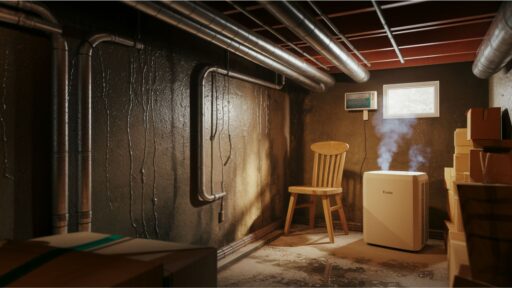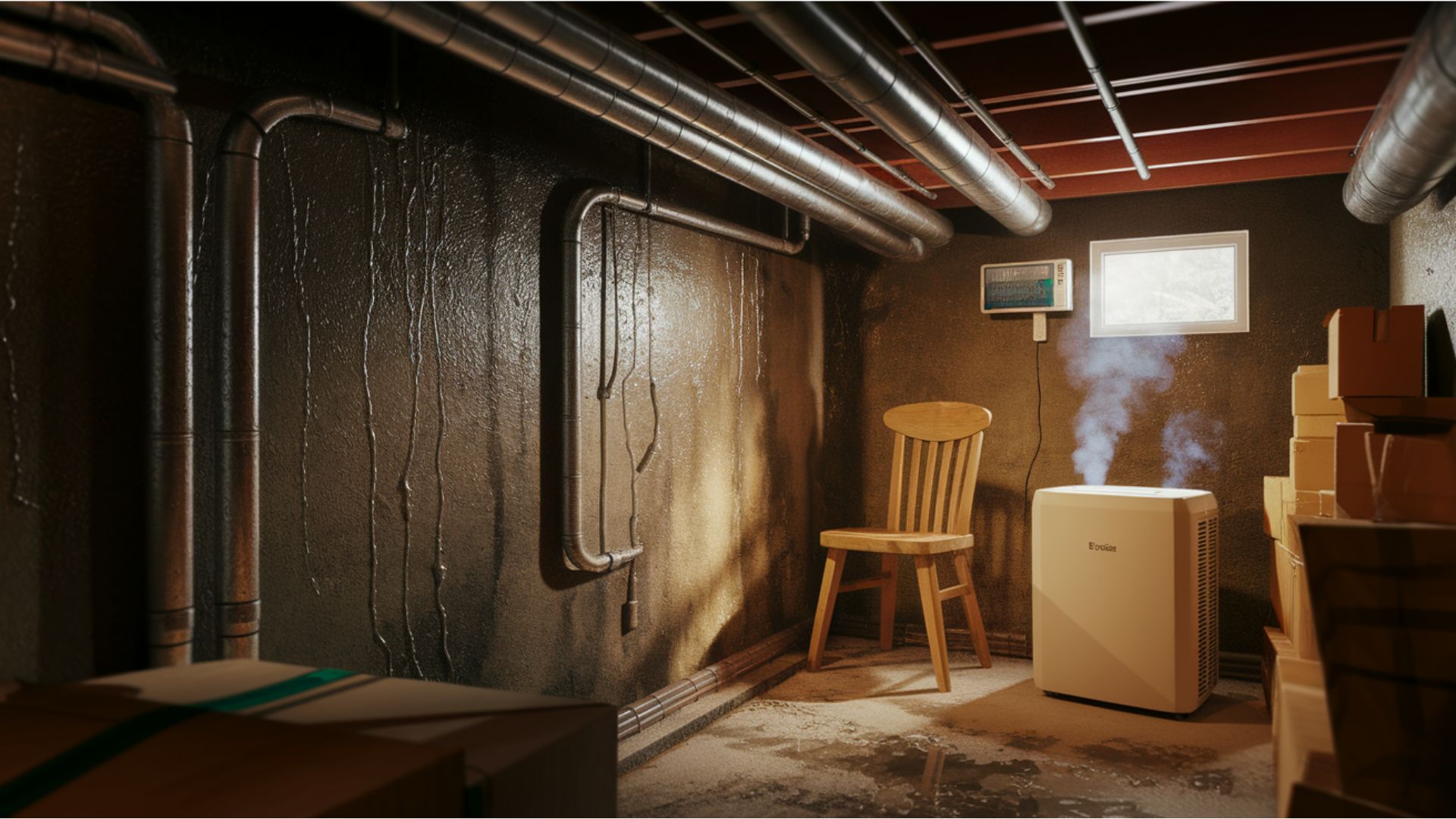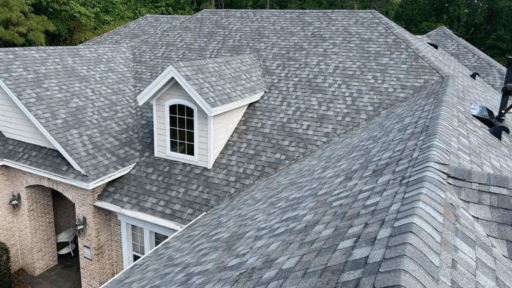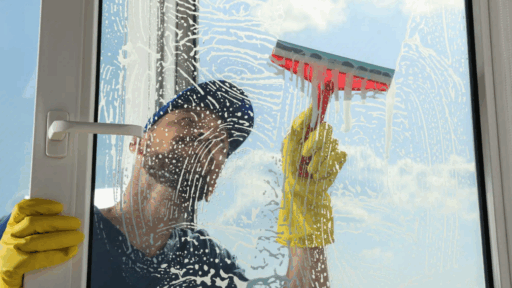Does your basement smell musty or feel uncomfortably damp when you go downstairs?
Your basement humidity level might be the culprit behind these annoying problems!
Basement humidity problems range from mold growth and musty odors to structural damage and health issues.
Maintaining proper humidity levels prevents costly repairs while creating a comfortable and usable living space below.
Excessive humidity can lead to mold growth, musty odors, and costly damage to your belongings.
Very little humidity can create static electricity, cause cracked furniture, and lead to respiratory irritation for your family.
Get ready to alter your basement into a comfortable, healthy space everyone can enjoy.
What is the Ideal Basement Humidity Level?
The ideal basement humidity level should stay between 30% and 50% year-round for best results.
This range prevents mold growth while keeping your basement comfortable and safe for your family.
Lower than 30% can cause dry air problems like static electricity and cracked wood furniture.
Higher than 50% creates perfect conditions for mold, mildew, and musty odors to develop quickly.
You can expect some seasonal changes, with summer bringing higher humidity and winter bringing drier air.
This optimal range protects your health by reducing allergens and respiratory irritants in the air.
It also protects your home’s structure by preventing wood rot, metal rust, and foundation damage.
Staying within this range saves you money on repairs and keeps your basement usable.
Why Basement Humidity Levels Matter
Have you ever wondered why your basement feels stuffy or smells musty even after cleaning?
Basement humidity levels directly affect your family’s health and your home’s condition in ways you might not realize.
Poor air quality from high humidity can trigger allergies, asthma, and respiratory problems for everyone in your household.
When humidity stays too high, mold, mildew, and dust mites thrive, creating an unhealthy environment that spreads throughout your home.
Structural damage becomes a serious concern as excess moisture causes wood rot, metal rust, and foundation deterioration over time.
Think about it – would you rather breathe clean, healthy air or deal with expensive repairs later?
Controlling basement humidity protects both your family’s health and your biggest investment.
Common Causes of High Basement Humidity
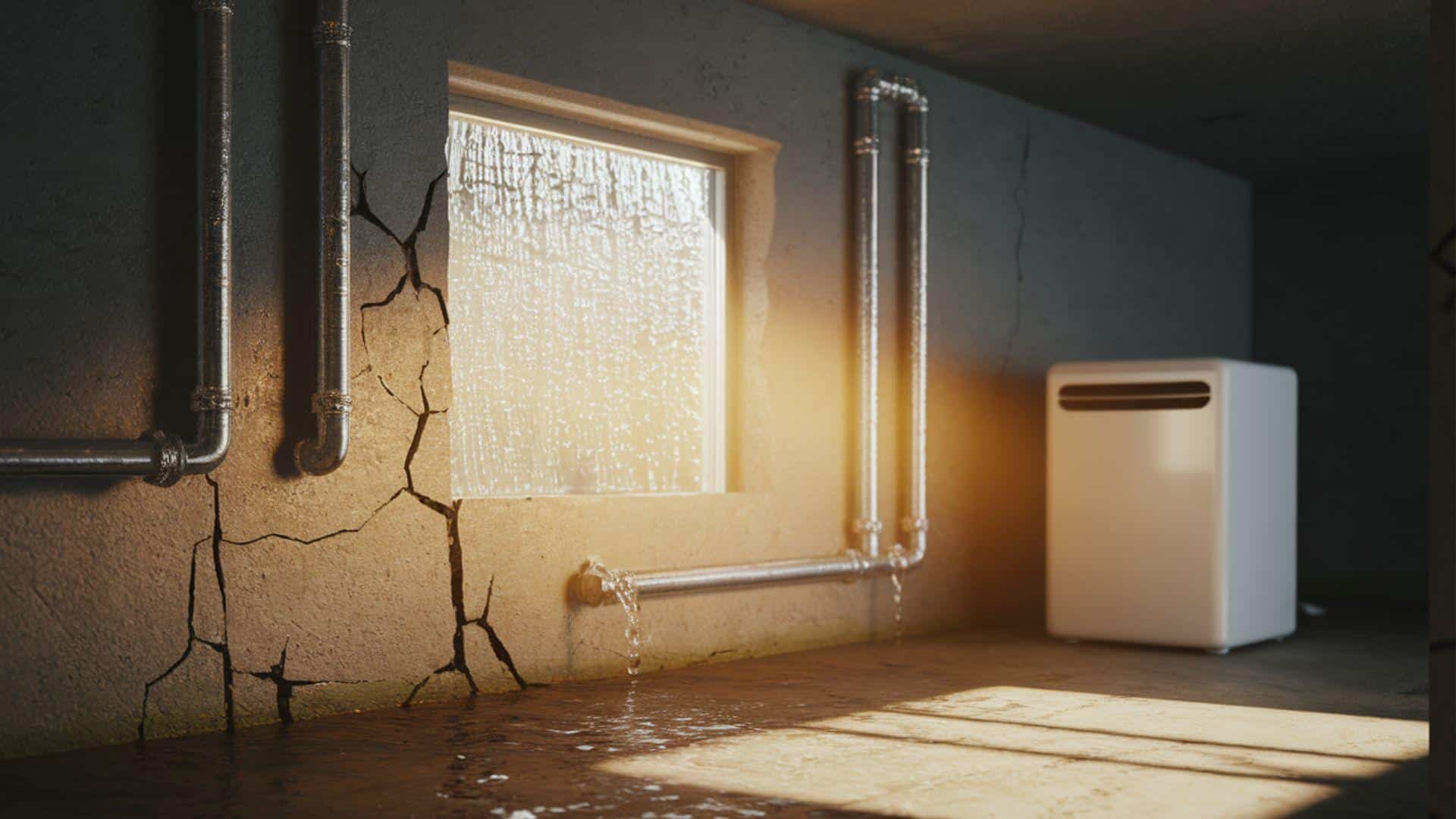
High basement humidity doesn’t occur naturally, and there are usually specific reasons behind it.
Understanding what causes moisture problems helps you address them at the source, rather than treating just the symptoms.
- Poor ventilation systems trap humid air in your basement with no way for it to escape outside.
- Water leaks and seepage allow moisture to enter through foundation cracks, windows, or damaged areas continuously.
- Inadequate waterproofing means your basement walls can’t properly block groundwater from soaking through the concrete.
- Plumbing issues like leaky pipes, water heater problems, or condensation from appliances add moisture to the air.
- Improper drainage around the foundation lets rainwater pool against your basement walls instead of flowing away properly.
Most humidity problems come from a combination of these issues rather than just one cause.
Addressing these root causes gives you better long-term results than just running a dehumidifier alone.
How to Measure Basement Humidity

Measuring your basement humidity is the first step to solving moisture problems in your home.
You need to know the exact humidity level before you can decide what action to take.
- Choose the right measuring tool, like a digital hygrometer, which is more accurate than analog versions.
- Place your measuring device in the center of your basement away from walls, vents, or heat sources.
- Check your humidity readings at least once a week, preferably at the same time each day.
- Take measurements in different areas of your basement to get a complete picture of moisture levels.
- Learn that relative humidity shows moisture percentage in air while absolute humidity measures actual water content.
Regular monitoring helps you catch humidity problems before they cause serious damage to your basement.
Keep a simple log of your readings so you can spot patterns and trends over time.
Health Effects of Improper Humidity Levels

Wrong humidity levels in your basement can seriously affect your family’s health and daily comfort.
Both too much and too little moisture in the air create problems for people.
Here are the main health issues you might notice from improper basement humidity levels.
- Respiratory problems and allergies get worse when humidity levels promote mold growth and dust mites.
- Asthma triggers multiply in high-humidity environments where allergens and irritants thrive in the air.
- Skin irritation occurs from both overly dry air, which causes cracking, and humid air, which promotes rashes.
- Sleep quality issues develop when uncomfortable humidity levels make it hard to rest peacefully at night.
- Immune system impacts happen when your body constantly fights off mold spores and other humidity-related irritants.
These health problems often start small but can get serious if you ignore humidity issues.
The good news is that fixing your basement humidity usually improves these symptoms quickly.
How to Lower High Humidity Levels
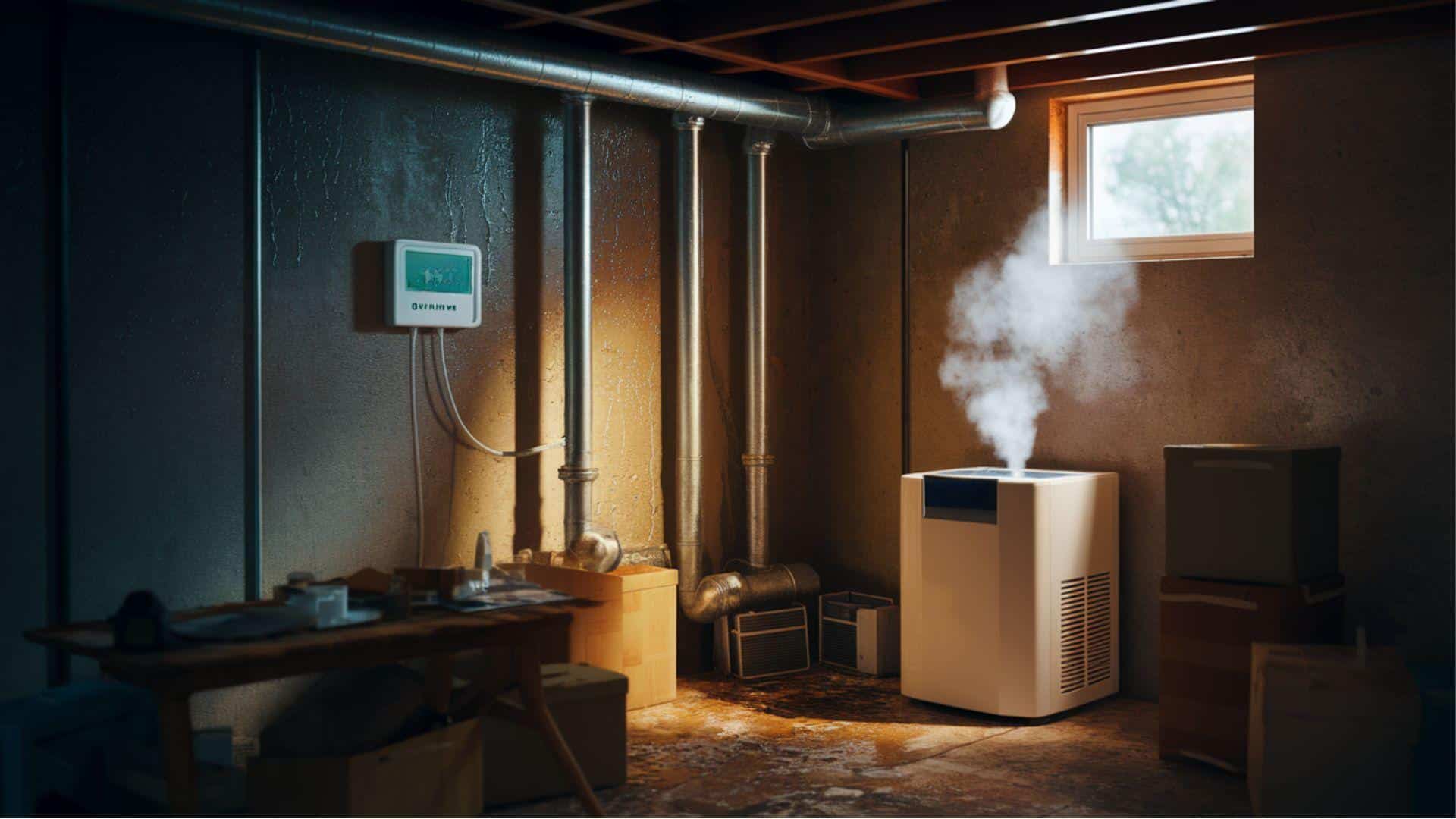
Lowering basement humidity requires both quick fixes and permanent solutions to be truly effective.
Immediate solutions help you control moisture right away, while long-term fixes prevent problems from coming back.
The best approach combines both strategies for lasting results that keep your basement dry.
Immediate Solutions
When your basement humidity is too high, you need fast action to prevent damage and health problems.
These quick fixes can lower humidity levels within hours or days of implementation.
- Run dehumidifiers to pull excess moisture directly from the air and maintain comfortable humidity levels daily.
- Improve air circulation by opening windows, running fans, or using exhaust fans to move humid air outside.
- Fix water leaks promptly by sealing cracks, repairing pipes, or stopping any source of water entering your basement.
These immediate steps provide quick relief but won’t permanently solve the underlying moisture problems.
You’ll need to combine them with long-term solutions for the best results over time.
Long-term Solutions
Permanent humidity control requires addressing the root causes of moisture problems in your basement structure.
These solutions cost more upfront but provide lasting protection against humidity issues for many years.
- Install proper ventilation systems that automatically exchange humid basement air with fresh, dry air from outside.
- Waterproof basement walls to prevent groundwater from seeping through foundation cracks and raising indoor humidity levels.
- Improve drainage systems around your foundation so rainwater flows away instead of pooling against basement walls.
- Add vapor barriers on walls and floors to block moisture from entering your basement through the concrete.
These long-term investments protect your basement and health while reducing the need for constant dehumidifier use.
Most homeowners find that these permanent solutions save money and effort in the long run.
What to Do About Low Humidity in Basements
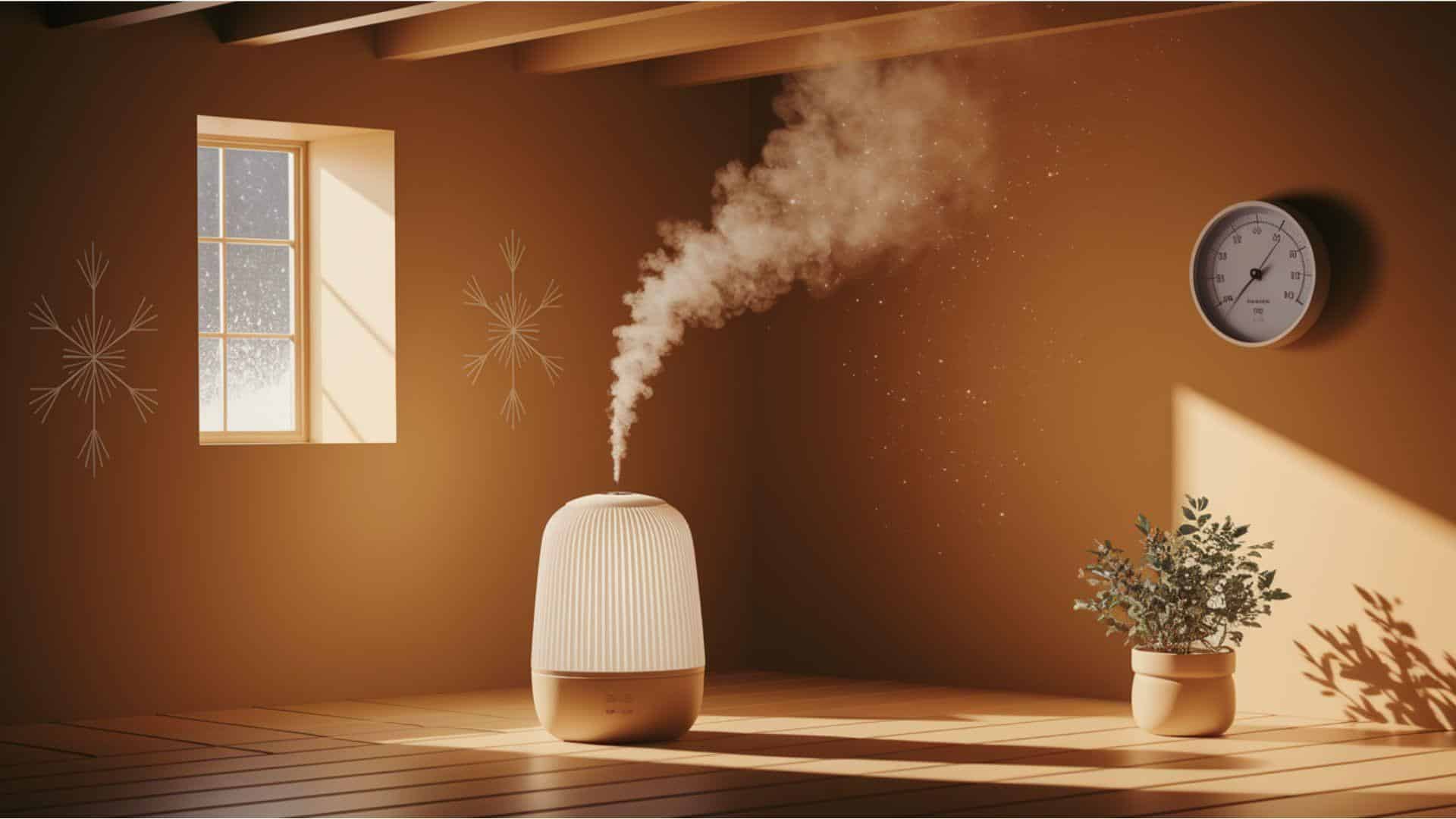
Low basement humidity often happens when heating systems over-dry the air, or cold winter air enters.
While this seems less concerning than high humidity, overly dry air can create problems such as static electricity.
Using a humidifier can help, but you need to be careful not to add too much moisture.
Place humidifiers away from walls and electronics, and regularly monitor the humidity level to stay between 30-50 percent.
The key is finding the right balance – add moisture gradually and check readings weekly for best results.
Consider portable units that shut off automatically when humidity reaches your target level to prevent overcorrection issues.
Top-Rated Affordable Basement Dehumidifiers
If your basement feels damp or smells musty, a dehumidifier can really help.
We picked some of the best affordable options that work well and are easy to use.
Here’s a quick look at the top-rated basement dehumidifiers on Amazon in 2025:
| MODLE | CAPACITY | HIGHLIGHTS | PRICE |
|---|---|---|---|
| Frigidaire 50 Pint | 50 pints | Fast removal, drain option, Energy Star | $250–$300 |
| hOmeLabs 3,500 Sq. Ft. | 40 pints | Built-in pump, auto-restart, large bucket | $220–$270 |
| Waykar PD160B | 34 pints | Compact, quiet, continuous drain | $120–$160 |
| Insignia NS-DH35WH1 | 35 pints | Quiet, easy to empty, 2,000 sq. ft. coverage | $200–$300 |
| Midea MAD35S1QWT | 20 pints | Wi-Fi, app/voice control, built-in pump | $120–$200 |
These dehumidifiers are easy to find online and do a great job keeping your basement dry.
Pick one that fits your space and budget best.
Preventing Humidity Problems Long-Term
Preventing basement humidity problems is much easier and less expensive than fixing them after they occur.
A simple maintenance routine helps you catch small issues before they become expensive repairs.
- The monthly checklist includes cleaning dehumidifier filters, emptying water tanks, and testing that the equipment runs properly.
- Use tools and smart home devices, such as hygrometers and moisture meters, to automatically monitor humidity levels.
- Follow seasonal care strategies by sealing cracks before winter and increasing ventilation during humid summer months.
- Inspect basement walls and floors quarterly for new cracks, water stains, or signs of moisture damage.
- Schedule professional inspections every two years to identify issues that may be missed during regular maintenance checks.
These simple prevention steps take just a few minutes each month but save thousands in repairs.
Starting a preventive routine now protects your basement investment for many years to come.
Wrapping It Up
Controlling your basement humidity level proves that small changes make a huge difference in home comfort.
From preventing mold growth to protecting your family’s health, proper humidity control pays off every day.
If you use dehumidifiers, improve ventilation, or fix water leaks, taking action protects your investment.
Regular monitoring and seasonal adjustments keep your basement comfortable throughout the entire year ahead.
Remember that prevention costs much less than fixing serious moisture damage after it happens.
Most homeowners wish they had started managing humidity sooner after seeing the amazing results.
Your basement can become a dry, comfortable space that adds real value to your home.
Ready to tackle your humidity challenges?
Share your basement success stories in the comments below!
If you’re interested in more home maintenance content, check out out other blogs that you might enjoy.

